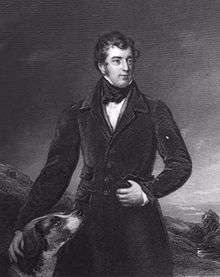Henry Reynolds-Moreton, 2nd Earl of Ducie
Henry George Francis Reynolds-Moreton, 2nd Earl of Ducie (8 May 1802 – 2 June 1853), styled the Hon. Henry Reynolds-Moreton from 1808 to 1837 and the Lord Moreton from 1837 to 1840, was a British Whig politician, agriculturalist and cattle breeder.

Early life
Ducie was born on 8 May 1802, the son of Thomas Reynolds-Moreton, 1st Earl of Ducie, and his wife Lady Frances, daughter of Henry Herbert, 1st Earl of Carnarvon.[1] He was educated at Eton. Lord Ducie married the Hon. Elizabeth, daughter of John Dutton, 2nd Baron Sherborne, on 29 June 1826.[1] They had eleven sons and four daughters.
Career
Lord Moreton entered Parliament for Gloucestershire in 1831, a seat he held until the following year when the constituency was abolished, and then represented Gloucestershire East until 1835.[1] After entering the House of Lords on the death of his father in 1840 he served in the Whig administration of Lord Russell as a Lord-in-waiting (government whip in the House of Lords) from 1846 to 1847, when he resigned. In Parliament he gained a reputation as an advocate of free trade. He supported the repeal of the Corn Laws and, as an agriculturalist, his views were influential.[1]
Despite his political career Ducie is best remembered as a leading agriculturalist and as a breeder of shorthorns. From 1851 to 1852 he was President of the Royal Agricultural Society.[1] The sale of his famous shorthorns shortly after his death in 1853 generated £9,000.
He was a prominent member of the Evangelican Alliance.[1]
Later life
He died on 2 June 1853 at his home, Tortworth Court, Whitfield, Gloucestershire aged 51, and was succeeded in the earldom by his eldest son Henry.[1] His wife, the Countess of Ducie, died in 1865. As his son Henry died in October 1921 without a living son, the earldom passed to another of Lord Ducie's sons Berkeley who had immigrated to Queensland, Australia.[2]
Legacy
The "Ducie cultivator" usually ascribed to him[1] is in fact believed to have been invented by the managers of his ironworks at Uley.
Arms
.png) |
|
Notes
- "OBITUARY FOR JUNE". The Empire. Sydney: National Library of Australia. 18 October 1853. p. 3. Retrieved 26 September 2014.
- "THE EARL OF DUCIE". The Queenslander. Brisbane: National Library of Australia. 18 February 1922. p. 10. Retrieved 26 September 2014.
References
- Kidd, Charles, Williamson, David (editors). Debrett's Peerage and Baronetage (1990 edition). New York: St Martin's Press, 1990,
- Leigh Rayment's Peerage Pages
- Leigh Rayment's Historical List of MPs
- Lundy, Darryl. "FAQ". The Peerage.
- Lee, Sidney, ed. (1894). . Dictionary of National Biography. 39. London: Smith, Elder & Co.
External links
- Hansard 1803–2005: contributions in Parliament by Henry Reynolds-Moreton, 2nd Earl of Ducie
| Parliament of the United Kingdom | ||
|---|---|---|
| Preceded by Lord Edward Somerset Sir Berkeley Guise |
Member of Parliament for Gloucestershire 1831–1832 With: Sir Berkeley Guise |
Constituency abolished |
| New constituency | Member of Parliament for East Gloucestershire 1832–1835 With: Sir Berkeley Guise 1832–1834 Sir Christopher William Codrington 1834–1835 |
Succeeded by Sir Christopher William Codrington and Augustus Moreton |
| Peerage of the United Kingdom | ||
| Preceded by Thomas Reynolds-Moreton |
Earl of Ducie 1840–1853 |
Succeeded by Henry Reynolds-Moreton |